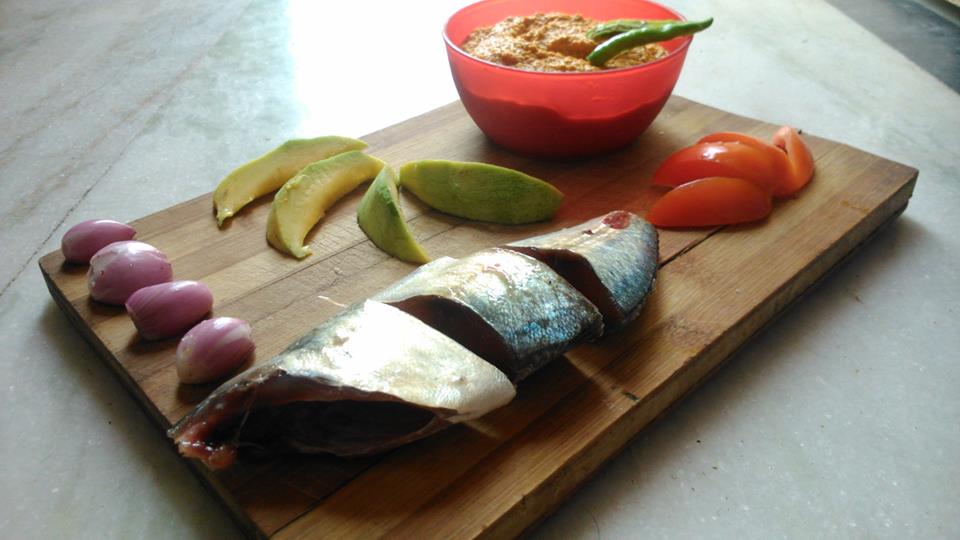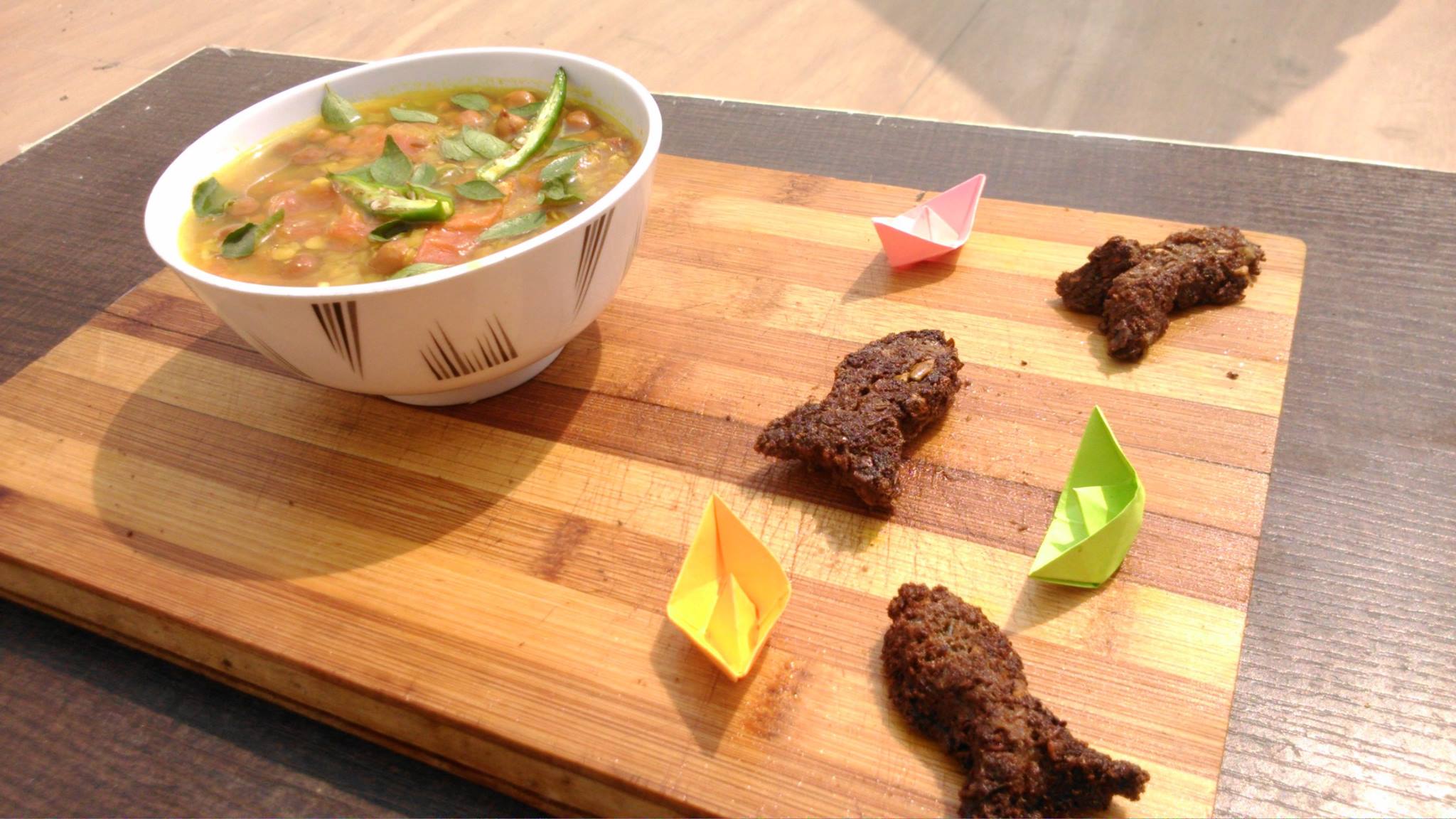Aamgasms in the Delhi Heat: Goan Fish Curry With Raw Mangoes
April 22, 2015By Padmapani Patowary
This is the best of times. Why? Mangoes! It’s almost mango season. It already is actually- but the varieties out in the market are selling at the price of elephants, as the Assamese saying goes. Whether one can afford mangoes now or not, the fruit allows wonderful opportunities for harmless voyeurism. When I was studying for the Civil Services exams with Anmol, we would stand by the street corners of Chittaranjan Park, or at Market No. 3 and gawk at girls eating mangoes. It was a highly sensual act- the girls would bite off a portion of the skin, squeeze the pulp out of the hole and suck on the fruit, juice running down their chins and arms. Since Anmol is visually challenged, I would describe the scene to him and we would giggle like teenagers. He would also ask me to describe the girls’ faces and I would do my best.
‘Big eyes’, I would say, ‘short, small nose, protruding chin’
‘Like a mango?’
‘Yes, exactly like a mango’.
Anyway, it is wonderful here in Delhi- the weather is mostly pleasant: because of the rains in Kashmir and because Delhi lives on borrowed weather, spring has stretched for a week more- time for a lazy walk in the Lodhi Gardens or Lutyens’ Delhi, a cozy evening on one of the roof-top restaurants at Paharganj (don’t go there for a meal though! I had the most horrible steak ever at Sam’s Café, a popular watering hole at Paharganj- a chunk of grilled (almost charred) unidentifiable meat in a gravy of mashed potatoes accompanied by potato fritters and boiled vegetables… horrible, horrible), a bicycle ride in JNU or a ramble through the Kamla Nehru Ridge where bougainvilleas and violets are in bloom and monkeys are in heat; the end-semester exams are near meaning there are fewer people at the gym (more time for my own work-out): in short, it is one of the best times to visit Delhi before the loo (dry hot summer wind) rides in and you feel as if a fire breather is blowing down your neck. This is also the worst of times: erratic showers of rain destroying crops, high pollution levels, and people murdering people in broad daylight in front of their children. But this is Delhi. And of course there are mangoes!
As Ghalib, the resident poet of Delhi once famously blasphemed,
Ask me! For what do you know?
A mango is far sweeter than sugarcane
Perhaps from the great heights above
The gardeners of heaven’s orchards have sent
By the order of God
Wine filled in sealed glasses
Delhi is where mangoes come to enjoy their youth. As the city is the nerve centre of North India, Delhiwallahs are spoilt for choice. Come February and chikoos, watermelons, kiwi fruit, musk melon and all the varieties of mango, oh glorious mango- Langda, Chausa, Malda, Alphonso Himsagar, Ratnagiri… I could go on and on… dance on carts and through your door, enter right into your hearts. In this wave of sweet pieces of heaven, one thing gets forgotten- the cute little raw mango. The potential of this condiment is immense. Dried and powdered, it can be stored and used for soups, curries and chutneys. Raw, it can be mashed into chutney, or eaten with crushed coriander leaves, chillies and rock salt. Finally, it can be cooked with fish. This is where the humble little fruit rocks! It adds just the right amount of tang to the curry and if properly stewed, it can also be eaten with rice. The following is a recipe I picked up in Goa. Goans claim that it is a traditional Konkani dish, so variations of the same dish can be found along the Konkan coast. Well, here is the recipe:
The requirements:
Sea fish- 500 gm. (All strong smelling sea fish will do. I personally use mackerel and sardines.)
For the masala:
Freshly grated coconut- 1 ½ cup
Kashmiri chilli powder- 3 tsp
Peppercorns- 6-7
Cumin seeds- 1 tsp
Coriander seeds- 1 tsp
Methi- 1 pinch
Ginger- 1 inch (cut into juliennes)
Garlic- 4-5 cloves (cut into juliennes)
Tamarind- to taste (Use a marble shaped ball of tamarind if you want it to be just a little tangy or a lemon shaped ball for more zest.)
For the Curry:
Raw Mango- Half, cut into wedges
Coconut oil- 2 tsp
Turmeric- ½ tsp
Onion- Half a small one chopped lengthwise
Tomato- A small one chopped finely
Salt- to taste
Curry leaves- 8-10 (Optional)
Coconut milk- 1 tbsp
Water- 2 cups
Procedure:
 Step 1: Wash the fish thoroughly and make long cuts on the sides. Salt them and keep aside.
Step 1: Wash the fish thoroughly and make long cuts on the sides. Salt them and keep aside.
Step 2: Roast cumin seeds, peppercorns, coriander seeds, methi, garlic and ginger on a pan for a minute. Add grated coconut and roast for two more minutes.
Step 3: Put the roasted ingredients and the rest of the curry ingredients in a grinder and blend to a fine paste with some water. The paste should be super fine as coconut chunks swimming in gravy don’t look appetizing at all.
Step 4: Heat oil in a deep pan and fry onion, curry leaves and tomato with salt. When the mixture turns into a paste, add turmeric, fry for thirty seconds and then add the masala.
Step 5: Cook the masala on a low flame until it is properly done. Keep stirring the mixture every minute. The masala when well-cooked should turn golden brown and the oil should separate from the mixture. Add water to get the required consistency and cook for a few minute over a slow flame. If you want the gravy to be thick, add coconut milk. Add the powder to a cup of warm water and stir properly. Then add it to the curry. It is important to know that the curry should be cooked over a low flame.
Step 6: When the curry bubbles, add fish pieces and mango wedges, cover the pan and let it stew for four to five minutes. Reduce the flame to a minimum. It is important to not let the gravy stick to the bottom of the pan, or worse, to have the fish half cooked. Slow cooking will release the flavor from both the fish and the mango wedges. The slightly sweet taste of coconut will enter the fish and make it nice and tender. Do not stir the curry at this stage. We don’t want the fish to crumble or let the mango wedges lose their shape.
That’s it. The Goan fish curry is done! This might be quite different from the traditional Goan fish curry but extremely yummy. Garnish it with warm ghee and serve with warm rice and Malabar papad. Eat with steady hands and be prepared for a Aamgasm!




